What made Sizzle sizzle
Published on March 30th, 2020
Bill Hardesty has been part of sailing’s winning history in the J/70, Etchells, Melges 20, Melges 24, Farr 40, winning a total of 12 World Championship titles, which include three in match racing.
For his latest trick, Hardesty entered his Hobie 33 Sizzle in the 2020 San Diego to Vallarta International Yacht Race, a 1000nm course from San Diego, CA to Puerto Vallarta, Mexico. As the smallest entry in the 29-boat fleet, Hardesty won it all after seven days at sea.
In this report from North Sails, we get the full scoop on what made Sizzle sizzle.
The crew
Hardesty’s crew consisted of Bad Pak [Pac 52] former owner Tom Holthus, Chuck Eaton, and Parker Mitchell. “A few months before the PV race, I got a call from Tom, and he said, “What’s up! I haven’t heard from you yet, are you doing the PV race?”. “Tom wouldn’t take no for an answer, and I knew it would be a great experience for the team, so I agreed.”
“It really was quite simple to join the Sizzle team,” said Holthus. “Bill and I had a great time sailing BadPak so the history was there. I sold BadPak after we won the Transpac and I had the time to help out. We both saw that the little Hobie 33 had potential. The boat can really move in lighter breeze conditions – just as well as any big boat – and we saw a lot of light breeze during the race.
“Billy is an awesome sailor. He sails offshore just like he does inshore – with high intensity where everyone had to and wanted to do their watch like it was a short dinghy race. We kept saying that we can sleep when we die.”
“We tested our systems with Patrick (North Sails’ Patrick Murray), practiced with our inventory to fine-tune, and figure out what we needed,” said Hardesty. “Patrick checked our sail repair kit and made sure we had the right batten tools. That was next level support.”
Murray commented, “I wasn’t the only one checking out the boat before the race. People were coming by to see how preparations were going on the ‘race winner’, so it was no doubt in everyone’s minds that they could win it.”
“We took the rig down and cleaned it up–we made sure we had Sizzle set up for success,” said Hardesty. “We cleaned the boat well and polished the bottom; we did everything we could do to gain speed. Tom made a good teammate, which was no surprise, and the entire crew kept the fun – factor high.”
Keeping an eye on the prize
Sizzle started the race on March 5 in ORR-6. Conditions at the start were north-westerly offshore, and once the fleet cleared the bay, it was DDW from there.
“We set the kite and sailed into the darkness, sailing as deep and as fast as we could,” Hardesty said. “We had originally planned to go between the islands, and we ended up not laying it, so we had to jibe. We lost a bit of distance, and the One Design 35 crossed us once, but once we jibed onto port, we got the boat going again and never saw them again.”
“Sizzle was ahead on the tracker almost all the time,” said Murray from his online view. “Every time I downloaded their latest positioning, they were holding down the lead. I was amazed how long they were able to hold off the bigger boats. It’s really amazing for a Hobie 33! Everyone had high expectations for this team, and it was great to see them leading.”
Hardesty commented, “We were pretty new to the systems on board, and I think that may have been to our advantage. Not having our tracker on kept us on our toes and not looking at the screen – it kept us working hard the whole time. We always assumed someone was outside, going faster, in better breeze – whether we could see them or not. We would jibe and catch a puff and ride that for a few hours; the crew worked hard the entire race.”
Once they got down to the Baja Peninsula, it got lighter and warmer, prompting the team to keep it simple. “We pretty much stuck to the rhumb line from there until we got to Cabo,” said Hardesty. “We did some sail changes to our light air sails – it was nice to have the options. Sea state was dead-flat, but that turned out to be in our favor. Once we built up our apparent wind, we were able to generate enough power to get her going fast and maintain speed with the waves.”
Once Sizzle made it to Cabo, they downloaded the tracker information and could see their positioning for the first time since the start of the race. “We could see the bigger boats offshore coming up quickly,” said Hardesty. “Pyewacket (Volvo 70 Modified) was one of them, but surprisingly there wasn’t anyone else in our division that was that close. It all worked out. Not knowing about other boats allowed us to focus on what we could do to sail faster.
“We saw there was more wind coming down the Sea of Cortez and we just kept focusing on sailing as deep as we could. The wind appeared to be shifting left, so we got back on the rhumb line. The crew was on the rail for the tighter reaches in the morning, sailing 100 to 110 TWA (true wind angle).
“I can’t say the boat liked that, but once the waves kicked up and the breeze shifted aft, we were back DDW and could bring the pole back 165 degrees. We hit nine knots at one point. The boat sailed exceptionally well in those conditions.”
Sail selection & crew management
North Sails 3Di 360 is made for smaller boats, and Sizzle’s new 3Di RAW 360 mainsail was twelve pounds lighter than Sizzle’s standard dacron main and made a positive impact on their performance.
Hardesty added, “We had a flat, smaller A1 which was good for the tight reaching and lighter stuff while the A2.5 was a rocketship for the middle ranges.
Explained Murray, “We built the A2.5 for the bow-up offshore points of sail. The 2.5 is optimized for planing conditions when the boat is ‘on the step’.
“Our genoa staysail was a Star jib, which gave us a half-knot increase,” shared Hardesty. “Overall, our mix of sail options, paired with the conditions we had, was what we needed to perform our best.”
Crew weight placement was important on this boat, especially in the lumpy conditions. “The boat is very narrow, so we had to be gentle when we would move about the ship,” said Hardesty. “If you had to wash your hands or use the head, you’d go forward instead of back to the stern.”
Small boat sailing offshore was a bit different than what Hardesty regularly experienced with Holthus on the Pac 52. The boat was super sensitive to any weight changes. “We were tip-toeing just like we would’ve done on a dinghy,” said Hardesty.
Sizzle finished on March 12, completing the course in 7:00:35:50 to win both ORR-6 and Overall.
Event Details – Results – Tracker – Facebook – Photos
The 2020 San Diego to Puerto Vallarta International Yacht Race got underway on March 5 for five teams in ORR-6 as they began the 1,000nm course from San Diego, USA to Puerto Vallarta, Mexico. Staggered starts continued on March 6 for 16 teams in ORR-3,4,5 and March 7 for eight entrants in ORR-1,2.
The multihull race record of 02:03:48 was set in 2018 by H.L. Enloe’s ORMA 60 Mighty Merloe. The monohull race record of 03:05:41 was set by Manouch Moshayedi’s Rio100 in 2016.
Source: Jeff Johnson, SDYC





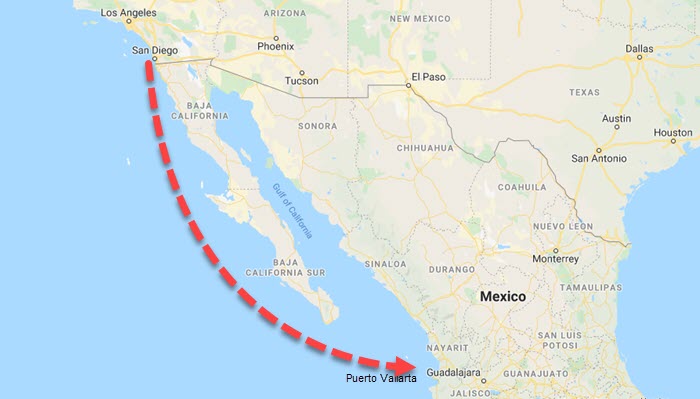

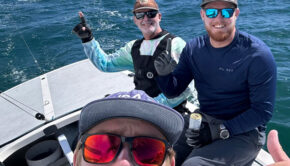
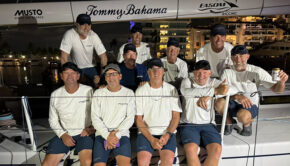
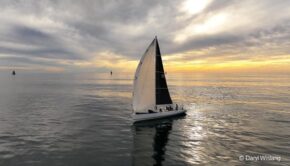
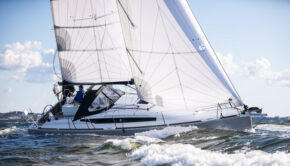
 We’ll keep your information safe.
We’ll keep your information safe.